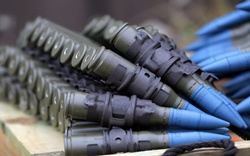After years of deliberations, the Indian Army has finalised a Rs15,000-crore project under which a range of ammunition for critical weapons and tanks will be produced indigenously to overcome long delays in imports and address the problem of a dwindling stockpile.

Confronted with ammunition stocks that would not last for even 10 days of “intense fighting”, the defence ministry and Army are now finalising a core long-term plan to get the domestic private sector to manufacture seven different types of ammunition.
The aim is to develop capability in the private sector companies, which can set up joint ventures with foreign manufacturers, to bridge the gaps in the production capacity of the 41 factories of the Ordnance Factory Board, according to reports by The Times of India and Press Trust of India citing sources.
Sources told PTI that 11 private firms would be involved in the ambitious project, the implementation of which is being monitored by the top brass of the Army and the defence ministry. The immediate aim of the closely guarded project — said to be the biggest ever initiative for the indigenisation of ammunition — is to create an inventory for all major weapons to enable the forces to fight a 30-day war, while the long-term objective is to cut dependence on imports.
“The overall cost of the project has been pegged at Rs15,000 crore and we have set a specific target for the next 10 years in terms of the volume of ammunition to be produced,” a senior government official involved in the project told PTI, refusing to elaborate.
Initially, ammunition for a range of rockets, air defence system, artillery guns, infantry combat vehicles, grenade launchers and various other field weapons would be produced under “strict timelines”.
The government was apparently jolted out of its slumber after the terror attack at Uri in September 2016 when it found that the 13-lakh strong Army simply did not have certain categories of ammunition to undertake a full-blown war with “intense fighting” for 10 days.
Similar was the case with the Indian Air Force and Navy, when the norm is that the force should have adequate war wastage reserves (WWR) to last 40 days of “intense fighting”.
Since then, contracts worth around Rs24,000 crore for ammunition, spares, engines and other reserves have been inked or are in the process of being finalised, mainly with Russia and Israel, under the revenue financial powers delegated to the three Services as well as capital acquisitions to build up adequate stocks for at least 10 days of war, according to TOI.
Under the 19 contracts worth Rs11,740 crore finalised for the Army, for instance, the force will get Smerch rockets, Konkurs anti-tank guided missiles, 125mm APFSDS (armour-piercing fin-stabilised discarding sabot) ammunition for its T-90S and T-72 tanks and other ammunition in the 2019-2020 time frame.
The armed forces have to maintain high operational readiness all along the 778-km Line of Control with Pakistan as well as the 4,057-km Line of Actual Control with China.
The new Rs15,000 crore plan aims to get the Indian industry to manufacture ammunition for infantry weapons like UBGLs (under-barrel grenade launchers) and AGLs (automatic grenade launchers), 122mm Grad rockets, electronic fuses and bi-modular charge systems for the artillery, and 30mm high-explosive incendiary ammunition for BMP-II infantry combat vehicles.
“The bids of 11 Indian private companies for these contracts to produce some initial quantities of ammunition were opened last month. The technical evaluation is now underway,” TOI’s source said.
Once the selected companies develop the capability to produce the required ammunition, contracts worth around Rs15,000 crore over the next 10 years will be progressively awarded to them, said officials.
Earlier this year, Army vice-chief Lt-General Sarath Chand had told the parliamentary standing committee on defence that the Rs 21,338 crore allocated for modernisation of his force in the 2018-2019 budget had “dashed our hopes” since it did not cater for even “committed payments” of Rs 29,033 crore for ongoing schemes and emergency procurements.
“Further, availability of 83 (55 per cent) types of ammunition was below the MARL (minimum acceptable risk level of ammunition stocks for 20 days) and 61 (40 per cent) types were at a critical level (less than 10 days). Availability of high-calibre ammunition for tanks and artillery are in a more alarming state. Moreover, in the absence of fuses, 83 per cent of the high-calibre ammunition currently held by Army is not in a state to be used operationally,” it had added.
 Confronted with ammunition stocks that would not last for even 10 days of “intense fighting”, the defence ministry and Army are now finalising a core long-term plan to get the domestic private sector to manufacture seven different types of ammunition.
Confronted with ammunition stocks that would not last for even 10 days of “intense fighting”, the defence ministry and Army are now finalising a core long-term plan to get the domestic private sector to manufacture seven different types of ammunition.





























